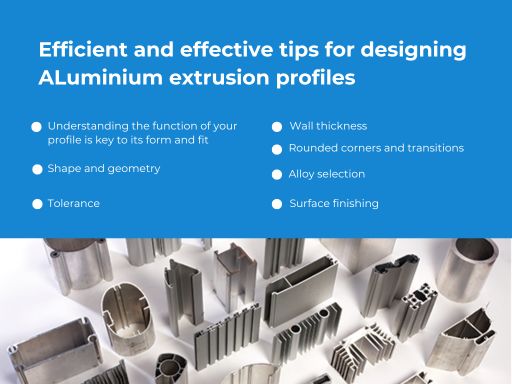Efficient and effective tips for designing aluminium extrusion profiles
Admin
2024-07-29
Aluminium extrusion is a versatile manufacturing process that produces an array of aluminium profiles used in diverse industries and applications. It is where aluminium is shaped into specific cross-sectional profiles. This is done by forcing it through a die. This versatile and cost-effective method has revolutionised aluminium production. It allows for various products across most industries. Designers prefer aluminium extrusions due to their strength, lightweight, and adaptability. This makes them ideal for most applications—these range from architectural structures to automotive components and solar panels.
 Understanding the function of your profile is key to its form and fit
Understanding the function of your profile is key to its form and fit
There is a fundamental principle in designing aluminium extrusion profiles. It is that the function of the profile decides its form and fit. Understanding the specific application and environment in which the profile will be used is crucial. This knowledge guides all your decisions. From material selection, wall thickness, and geometric features. This ensures the final product meets performance and cost-efficiency targets.
Tolerance
Tolerance means the allowable deviation from the required dimensions of the extrusion. It’s vital to balance the need for precision with cost implications. Overly tight tolerances can complicate production and increase costs, while too loose tolerances might compromise functionality. Work closely with your extruder to determine the appropriate tolerances for your design.
Wall thickness
Wall thickness is another crucial factor. Uniform wall thicknesses are generally easier to produce and ensure consistent cooling after extrusion, reducing the risk of structural inconsistencies. Thinner walls can save weight and material costs but may increase scrap rates and production difficulties. Aim for a wall thickness that balances strength, weight, and manufacturability.
Rounded corners and transitions
Design profiles with rounded corners and smooth transitions between different wall thicknesses. This can greatly improve manufacturability. Sharp corners and abrupt changes in wall thickness led to uneven cooling. This creates structural weaknesses and aesthetic issues. A radius of 0.5-1 mm for corners is typically recommended.
Shape and geometry
The shape and geometry of your aluminium extrusion profile are critical. While complex shapes can be achieved, simplicity often enhances manufacturability and efficiency. Symmetrical profiles, for instance, are easier to produce and distribute mass more evenly. Asymmetrical profiles can pose challenges, increasing the risk of deviations and damage during production. If your design requires asymmetry, consider breaking it into multiple elements. These can be assembled later.

Alloy selection
Choosing the right aluminium alloy is essential. It helps in achieving the desired properties in your extrusion profile. Some common alloys like 6061 and 6063 provide a balance of strength and ease of use. This makes them popular choices. The specific alloy you select should align with the parameters. This includes strength, corrosion resistance, and malleability. Post-extrusion treatments, such as heat treatments or tempering, are important too. They can further fine-tune the material properties.
Surface finishing
Surface finishes improve both the aesthetic and functional properties of aluminium extrusions. Anodising improves corrosion and wear resistance. It also allows for various metallic colours. Powder coating and painting offer more durability and aesthetic appeal. The choice of surface finish should consider the intended use and desired appearance of the final product.
Efficient manufacturing design
Designing for manufacturing efficiency can significantly reduce production costs and improve product quality. Consider the following strategies:
1. Die design: Ensure your die design promotes consistent material flow and minimises die wear. Symmetry in die design can aid in achieving uniform profiles.
2. Post-processing: Factor in any required post-processing, such as CNC machining or additional treatments. Design your profile to facilitate these processes, which can save time and reduce errors.
3. Environment: Go for eco-friendly alloys. Collaborate with profile manufacturers who use sustainable practices. Using recyclable materials lowers both costs and environmental impact. Aluminium is the metal that will power the green transition. Thus, it is important for its production to be eco-friendly as well.
Prototyping and iterative design
Before committing to a full production run, prototyping is very important. It lets you identify potential design flaws and areas for improvement. Use feedback from the prototype to refine your design. Ensure it meets performance and cost parameters.
Designing aluminium extrusion profiles efficiently requires a thorough understanding of the application. Careful consideration of shape, tolerances, thickness, and finishes is needed. By collaborating closely with your extruder, you can optimise your designs. This helps in manufacturability, cost, and performance.
Categories
Raw Materials
Scrap
Consumables
Primary Aluminium
Secondary Aluminium
Equipment
Technology
Downstream Products
Finished Products
Utilities
Services
Others
Recent Blogs
Subscribe to newsletter
Connect with us












